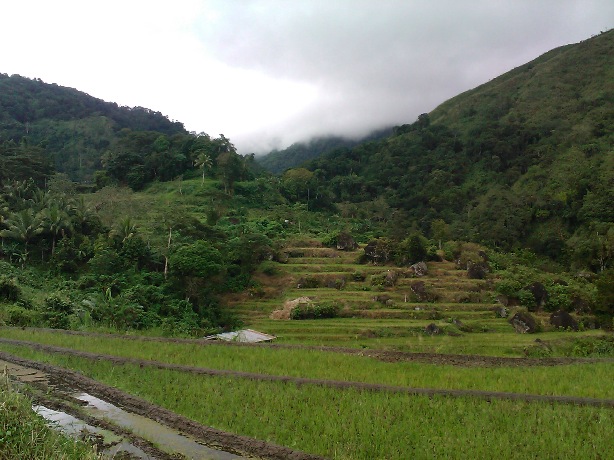

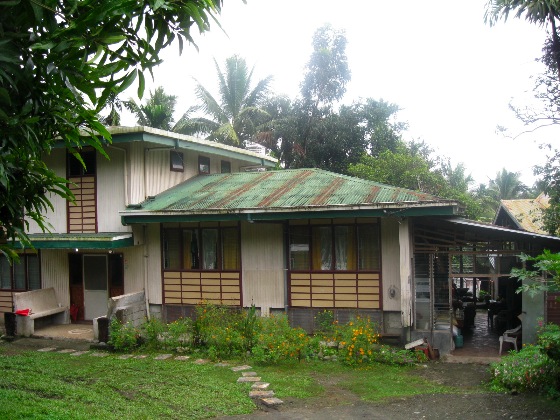
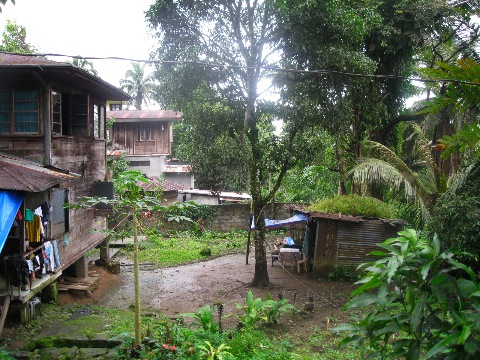
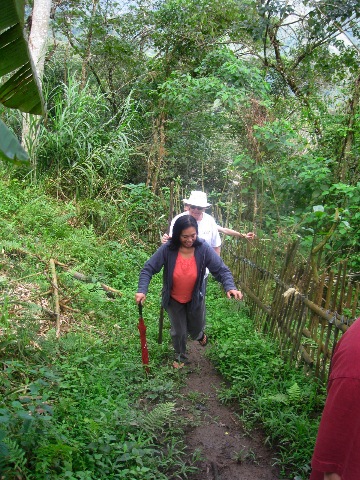 |
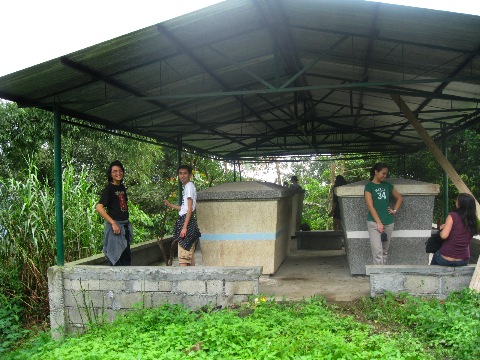 |
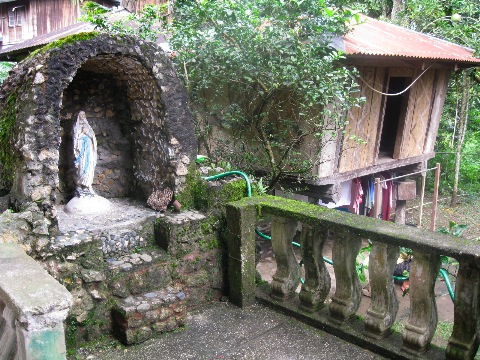 |
While the ritual we were there to attend is a traditional Ifugao ritual, the family--like most in the Philippines--is also deeply Catholic. There is no disjunction felt--it's all part of a unified life. This shrine is in back of the Getchell house. |
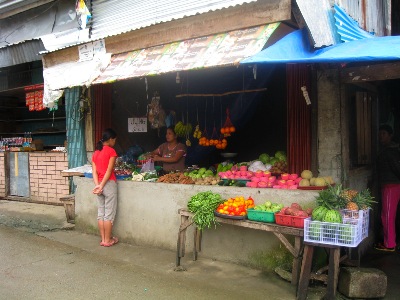 Some other photos in the village--there are many stores like this in the village, selling food and other small daily items. There are no large commerical buildings. Kiangan has about 15,000 people, including not just the village itself but the surrounding area. A bigger city, Lagawe, which has a bus station, banks, a large commerical area, etc., is about 30 minutes away by car. |
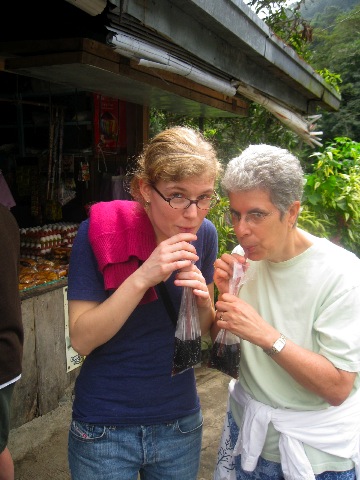 Small stores like this sell "Coke in a bag," keeping the bottles for themselves for recycling; here I'm with Katie Ortner. |
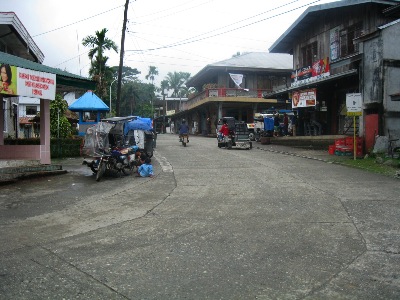 A view of a main street in Kiangan. The vehicles in the left and right of the photo are "tricycles," which consist of a small motocycle with a covered side car. With a couple of people in back of the driver and a few in the side car, these take around a lot of people! They are the main means of motorized transport in the village and are also prevalent in bigger cities and on intercity roads as well. |
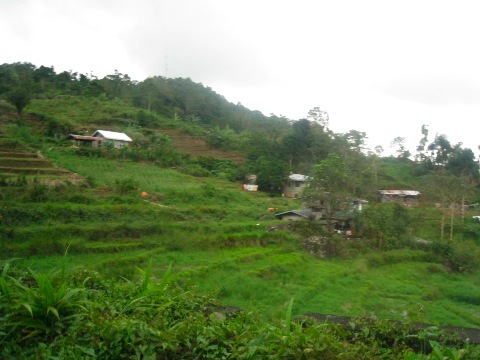 rice terraces just outside the village |
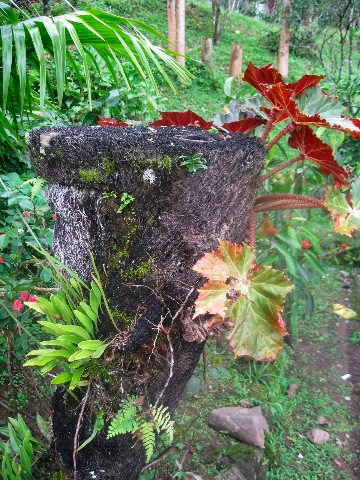 an example of the lush foliage |
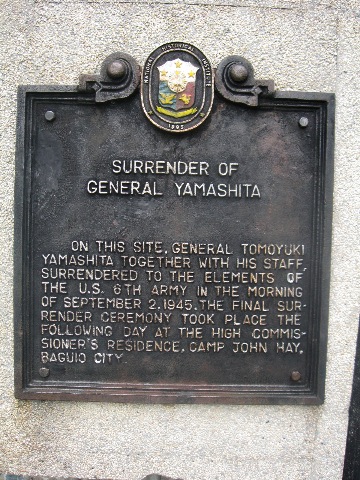 Kiangan has a special place in the history of World War II. The Philippines were occupied by the Japanese during WWII, and there was fierce fighting between Filipinos and Americans against the Japanese. Manila was flattened from air attacks by both sides, with huge human casualties and general devastation. The final surrender of the Japanese took place in the north, in Kiangan. This plaque is close by the tombs of Jean's family. |
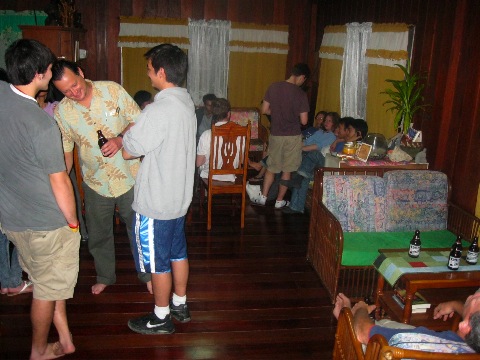 This is the inside of Jean and Mark's house, showing the large living room filled with some of the many people who had travelled great distances to be with Peter and Maya on this occasion. A dozen friends of Peter and Maya from high school, college, grad school and work came from Germany, Singapore, Boston, California and other places. Maya's four siblings plus Katie Ortner were other young people there. A Peace Corps friend of Mark's came from Wyoming, and Jean's family gathered from both sides of the Pacific Ocean as well. Also joining in were friends and relatives from Kiangan, some of whom were hosting some of us in their homes. (The beautiful wood floor is from local mahogany.) |
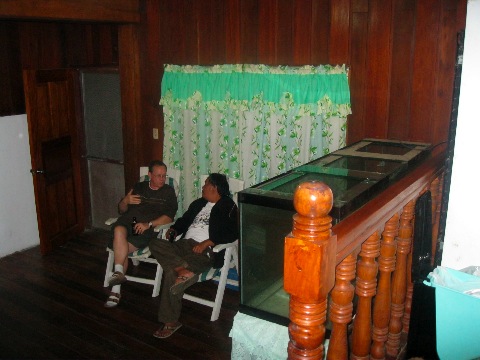 This is a lower level of the house--more mahogany in the panelling. David is talking to Jean's brother Albert, who gave us lots of advice in the preparation for the ceremony. Jean and Mark's generosity to us throughout the trip put me in awe. For example, they gave one bedroom in their house to the 3 Ortners, one to David and me, and a third to the driver of the van. This left one bedroom (with mattresses spread from one side of the room to the other) for the 7 members of the Getchell family. They fed 20 guests for a week, arranged all our transportation, figured out in advance anything we might need. Such deep hospitality--it made me think of how valued "hospitality" was in so many premodern societies. |
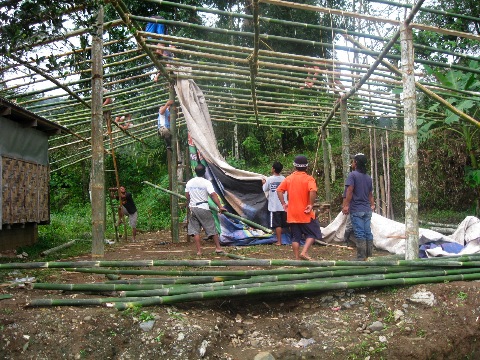 A couple of days before the ceremony, we went to Grandpa's house for lunch. Workers were putting up a covered pavilion for the party--all the posts are local bamboo, with a big tarpolin recycled from commercial use for the roof. A lot more work than renting a tent! |
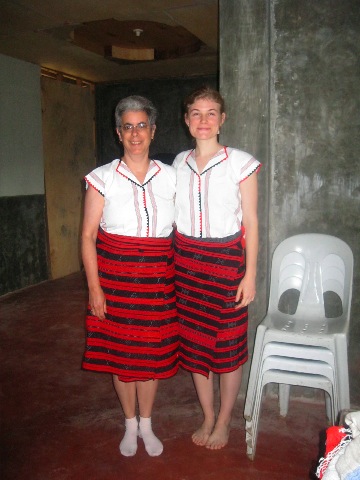 Early on the morning of the ceremony, we drove over to the "groom's house" and put on traditional dress. The skirts are a rectangle of Ifugao weaving--red, black, and a little white are the standard, with sometimes also some yellow. The blouses are hand-embroidered. |
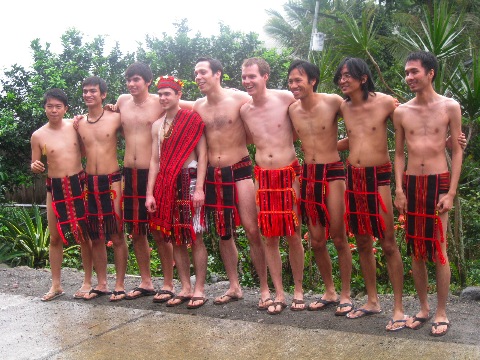 The men's garb was more dramatic--a one-piece loincloth. Peter is the one wearing a drape over his shoulder. The others are Peter and Maya's friends from high school and college as well as Maya's two brothers. |
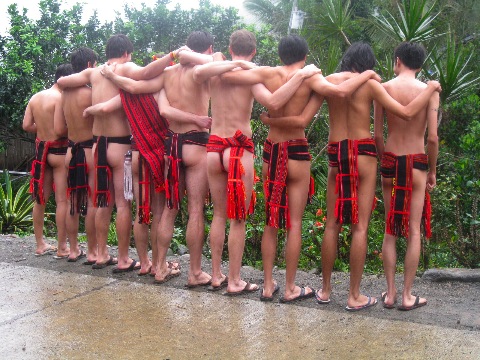 The rest of us taking photos couldn't resist this shot. Yes, Rick and David wore the same garb, but photos of them here will be more discreet. |
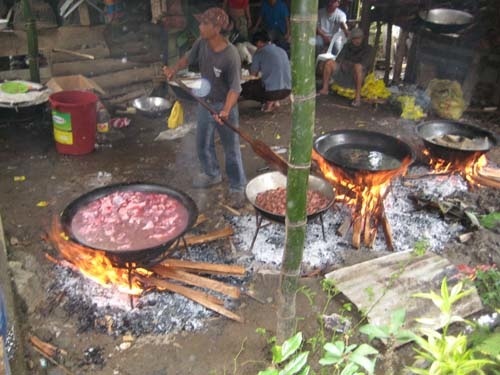 Well before we got to the house, food preparations had begun--very large pots set out in a cook tent set up for the occasion. |
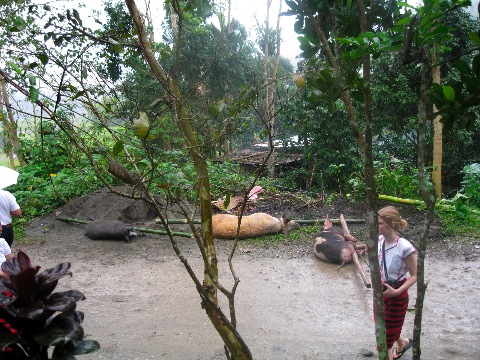 Here are the three pigs, still alive, trussed and tied to the poles, just before the procession started. The middle pig weighed 200 kilos (440 lbs.). Each pole was lifted by two people, but then other friends/family stepped up to help carry them. It was also good that one house was only about 20 yards from the other. If a pig is dropped it's a very bad omen! |
 Tim and Georg, with a little help, carry the largest pig. |
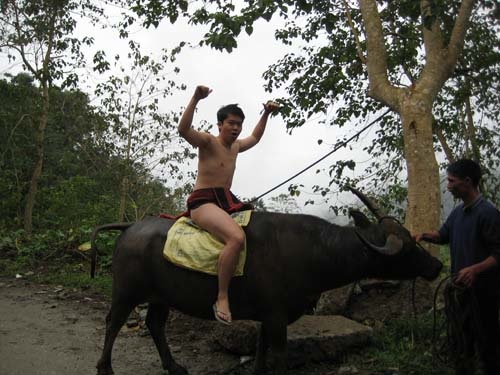 This is Alvin riding the carabao (water buffalo). |
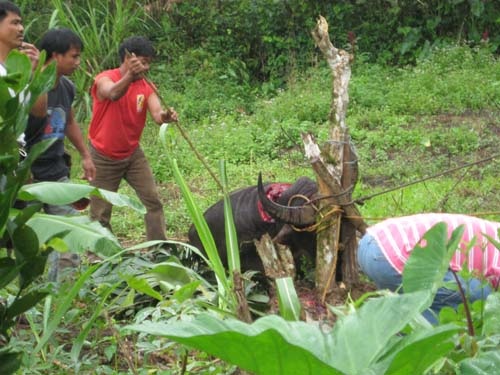 The carabao is slaughtered. Both the carabao and pigs are cooked and served to the guests, with the extra meat distributed to family at the end of the day. |
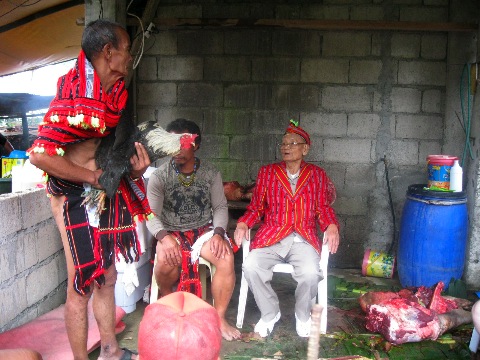 Then the bride, groom and immediate family were gathered close by the shaman/priest ("mumbaki"). You can put these two photos together for the setting (note blue barrel in both). The shaman is standing at the left, holding two chickens, which he moved around as he offered the carabao and pigs to the dieties for divine favor. Seated next to him is a young priest in training, who explained much of the ritual, and next to him, in the red jacket, is Grandpa, who also explained parts of the ritual. In the bottom right corner: a haunch of the carabao. Prayers were said for the two families, and for the the animals that were being sacrificed on the occasion of the union of these families. |
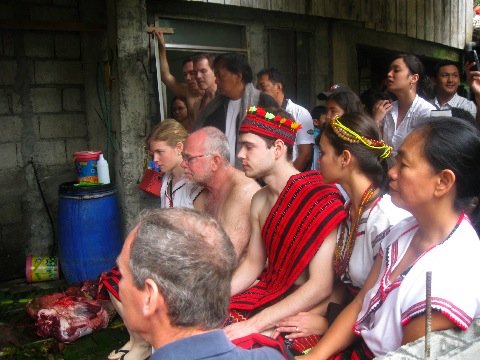 Seated with his back to the camera is Maya's dad Mark, then from the right corner to the center: Jean, Maya, Peter, Rick, Katie. |

 This tray holds various ritual elements, including a large sheaf of rice stalks. (Grandpa is wearing the white Crocs.) |
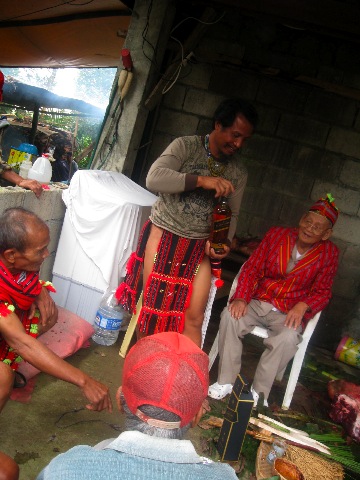 We present the bottle of scotch to the shaman (it's here held by the young shaman-in-training). Mark had joked that this is given to put the shaman in the right mood for a good reading, and he did take a drink before proceeding. The omen consists of reading the bile of the two chickens. If the bile doesn't look good, the ceremony can be called off. We heard of one case where such a poor reading was given (there was no bile visible). But the family apparently went ahead with the ceremony in any case--there's so much effort already expended--though it reportedly was a bit gloomy. |
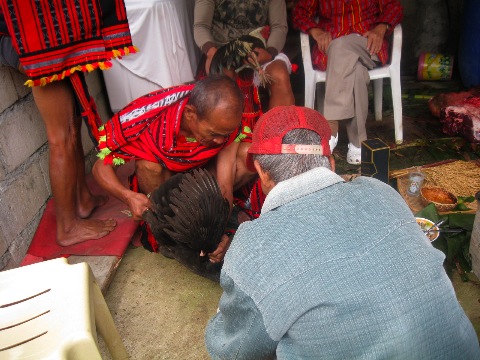 Here the shaman holds the chicken while another man cuts the throat of the chicken, collecting the blood into a small bowl. This is also done with the second chicken. |
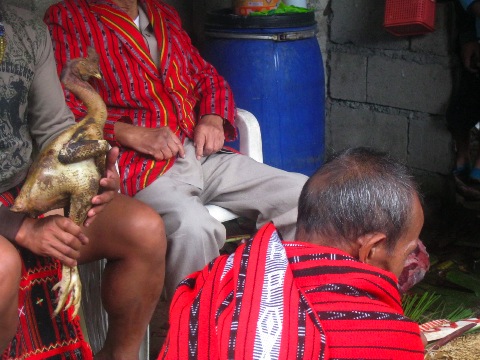 The chicken was then plucked and singed, and brought back to the shaman. |
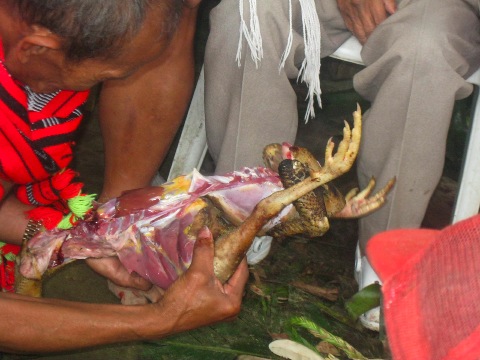 He splits open the animal to reveal the bile. |
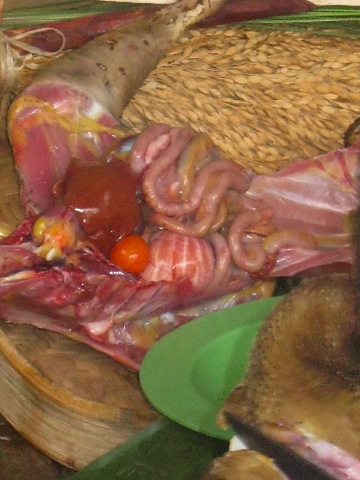 It's OK! Same thing repeated for 2nd chicken; it was also OK. Peter was very relieved--he mentioned later that he'd been worried about this part. |
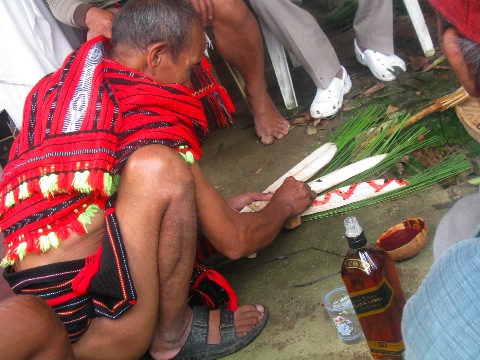 With the blood of the chicken, the shaman paints a traditional design onto 3 pieces of wood that are bound together with some greenery. This is meant to be taken into the bride and groom's home. |
 Here you can see the finished design on the wood. |
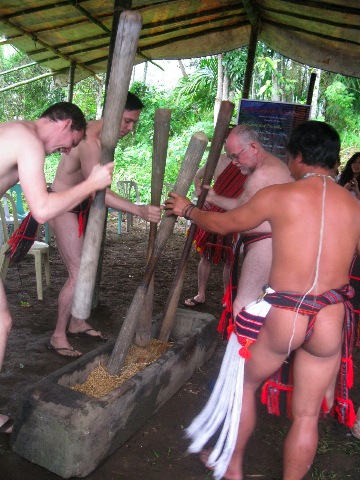 Next step--the pounding of rice. This is done with a local variety of rice that has a hull so hard that it cannot be mechanically milled. Rather than a simple pounding, this was to be done in a rhythmical way that made music of the task--hitting the sides of the trough as well as the rice itself. The gringos did this for a little while, and then the villagers took over to get the job done. |
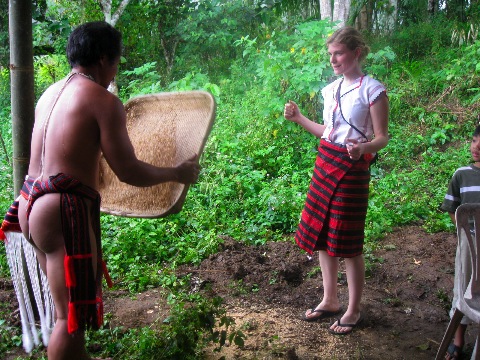 Then the rice was winnowed. Katie and other women get instruction. It was difficult! |
 Then another pounding, this time in a large stone mortar. |
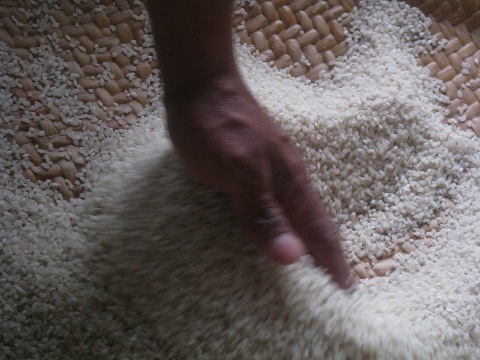 And then--beautiful, hand-milled rice! This was then cooked for the meal. |
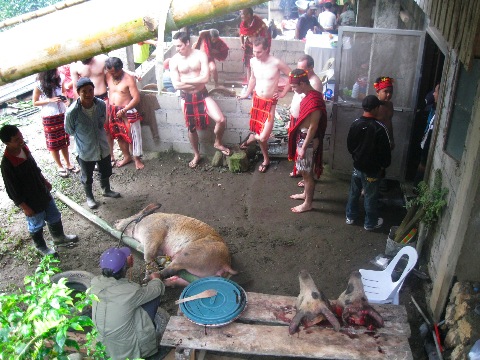 Now it's time to kill the pig. This was done very effectively with one stab with a sharpened stick. |
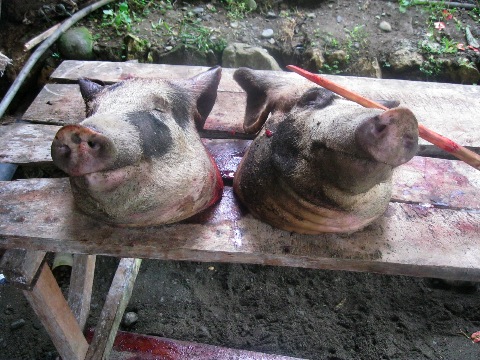 These are the remains of two pigs who had been killed the previous day, to help with the provision of food for the feast. |
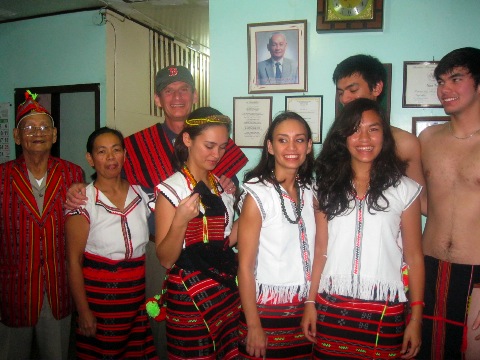 Grandpa, and the Getchell family: Jean, Mark, Maya, Cara, Leah, Sean, Connor. At this point in the day there was time for some "formal" photo taking. |
 Peter and Maya are wearing jewelry special to the occasion. The gold necklaces are family heirlooms--to be worn on such occasions, but not given to them. |
 |
 Then the party! First the
family of the groom was introduced (all us friends included) and then
the family of the bride. Then the music began with a traditional
gong orchestra--here you can just see one of the round gongs.
|
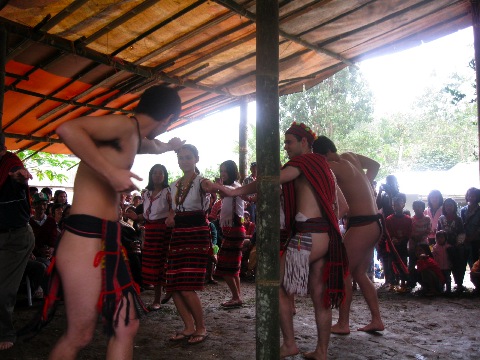 During the gong music, the bridal parties did a traditional dance, which we had learned the night before. As you can see from the previous photo and this one, only the participants from the families were wearing traditional dress; everyone else was wearing modern western clothing. |
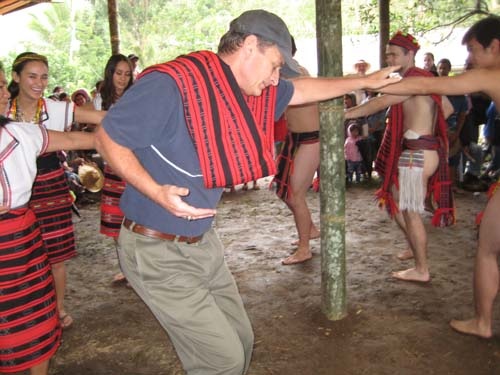 Maya's dad explained to us later that the gesture of the left hand signifies holding out an enemy head, brought back after headhunting. |
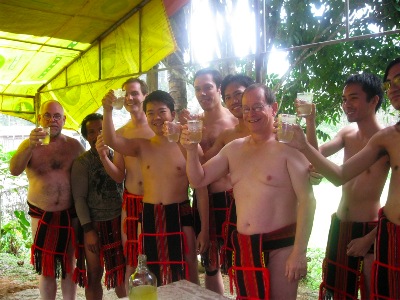 Drinking locally made rice wine is also a key part of the ritual! |
 After the gong music, on to the karaoke machine! Karaoke is very big in the Philippines. We sang and danced for a long while. While we partied, the cooks were cooking. Then we all had a big meal. |
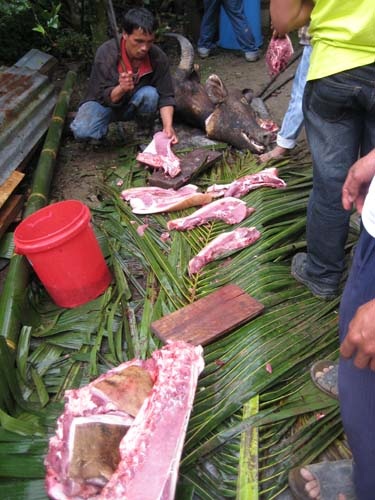 Earlier in the afternoon, much of the meat was divided up and distribute to relatives. |

